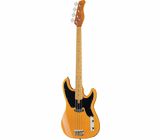No, but it largely overcome the Squier classic vibe p-bass ‘51.
Short review. Are you looking for a nice looking, well built, vintage style single coil p-bass? Look no more and grab this one.
Detailed review. If 6 months ago I were not in the need of a 5-string, now I would be here reviewing the Squier CV ‘51 p-bass.
But since I bought a Sire v3 -and fell in love with it, in spite of the active pre-amp, the 5th string and the ugly headstock- now I’m here spending nothing but good words about this d5.
So let’s start with the “cons”: the deep end of the Fender is not there, period. But the Squier doesn’t have it either. I’m done with the cons.
Pros:
The overall construction of the instrument is good. Maybe I was lucky, but the body is a single piece of Alder, and where the waist cut off is, the wood nervature draw beautiful concentric curves that one can appreciate because of the very thin paint.
The neck is great. Satin is the back, for speed also in heavy sweat. The roasting hardens the wood, making it more suitable to withstand the forces at play. Besides, it look gorgeous.
The pickup is not noisy at all. Lowend Lobster mentioned that it looks like a single coil, but is in fact a split. It doesn’t look like that to me, but is as noiseless as a split. Great sound, plenty of overtones and excellent note resolution, thanks to the single coil. Pity that the deep end of the lows is not there.
Electronic. I did not yet open the electronic’s cave (UPDATE: the pots are made in Korea and are by all means identical to the CTS ones; the PuP wiring is insulated with waxed cotton, as for high end Fender instruments), but the pots are absolutely silent, as they are on the v3 (and believe me, the v3 has a lot of them)
Hardware. Essential, with a touch of vintage (those brass saddles are cute). Be aware that the bridge has no grooves for the saddles’ screws. But so it was back in the days. The bridge itself has definitely a higher mass than the vintage bridges you see around.
Painting. Nothing to say: smooth and thin, to appreciate the wood below - UPDATE: thinking twice, the blonde butterscotch seems having a bit too much of orange hint, but it's a matter of taste
- UPDATE: I forgot to praise for the presence of a massive 3-way string guide, which prevents bumping of the A string.
So&sos
Tuning gears on the sloppy side: it seems they keep the tuning, but their response is not linear - UPDATE: the gears were only very dry! With a little of lithium grease they work as a charm
Strings are cheap
Action is too high. But I’ve read that is pretty standard for basses made in Indonesia - UPDATE: it has been 2 weeks that I'm now working on action. I do it slowly also because the roasted neck is slow responding, as expected. The results are eventually coming (I play with very low action; in the case I use it for grunge or punk, the fret buzzing adds some nice dirt to the sound).
Summing up, for a few more € than for the Squier, you get a bass that objectively offers much more. The playability of the neck, the good-to-very-good sound and the overall look and feel make this bass a hell of a catch, for 450€.
Great job Sire. Keep on listening to Sir Marcus (but please re-design the headstock!)




